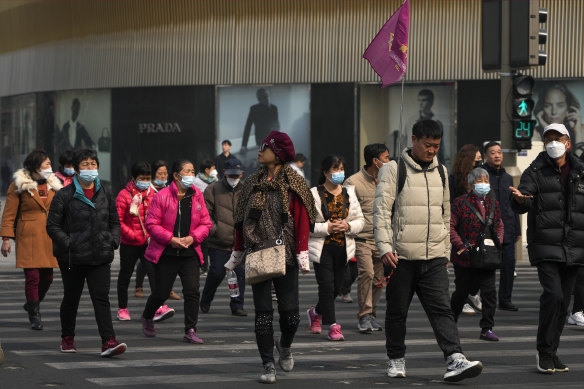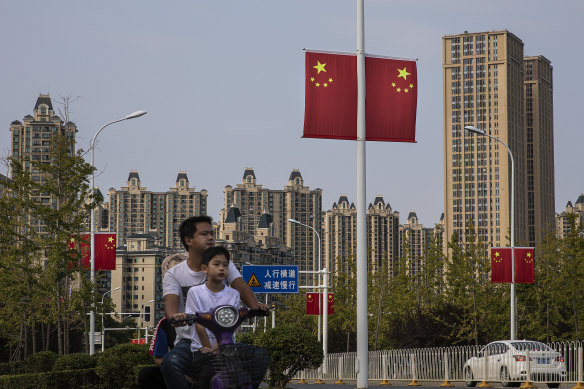
China just shook up its crystal ball in a very curious way
The NDRC identified the risks faced by the economy, which included competition with other major economies, geopolitical conflicts, continuing supply chain constraints and weak domestic demand.
“Financial risks are on the rise and fluctuations in global financial markets are intensifying. Cross-border, cross-market and cross-sector risks have become more inter-related,” it said.

China’s economy faces headwinds but ought to rebound significantly this year.Credit:AP
The external conditions are challenging and uncertain. The global economy is slowing as central banks try to douse raging inflation rates. The US and, increasingly, its Western allies are intensifying their efforts to restrict China’s access to advanced technologies and contain its economic growth. The war in Ukraine adds another layer of uncertainty and risk to an economy exposed to imported energy and foods.
It is the condition of China’s domestic economy, however, that may be making the leadership cautious about the outlook.
Business and consumer confidence was battered by their experiences last year. The property sector, once a major driver of growth, was driven to its knees by Xi’s “three red lines” policy restricting leverage and is still struggling to find stability despite significant state support.
Property prices have fallen steeply, impacting household wealth and confidence and, coupled with the major downturn in property market activity, has squeezed over-leveraged local governments that depend on property-related income.
The conservative economic outlook and fiscal forecasts point to a greater focus on financial stability and the quality of economic growth than its quantity.
The crackdown on tech companies has stifled ambitions and investment and signs that Beijing has now turned its sights to a new crackdown, this time on alleged corruption in the finance sector, is likely to have a chilling effect there, too.
The relatively modest economic ambition for this year, which is dependent on a recovery in consumer confidence and spending, doesn’t include any significant stimulatory measure or, for the property sector, anything other than a vague statement of support for “high-quality” developers while continuing to constrain “disorderly” expansion.
In tech, Li Keqiang referred to a “whole nation strategy” for responding to the Biden administration’s continuing efforts to throttle China’s tech sector with almost daily blacklisting of Chinese technology companies and, with its allies, cutting off access to the advanced semiconductors vital to most advanced technologies.
It should be noted that, despite vast investment by the state, China’s efforts to develop a domestic capacity to produce those computer chips have so far been less than successful.

China’s property woes continue to weigh on sentiment. Credit:Getty
China’s budget for this year reflects the cautious approach, with a fiscal deficit of 3 per cent of GDP forecast (last year the deficit was 2.8 per cent of GDP) and the quota for local government bond issues reduced from 4.15 trillion yuan (just under $1 trillion) to 3.8 trillion yuan (about $814 billion).
That says there isn’t a massive wave of infrastructure investment planned to stimulate the economy, which may be a reflection of the stretched state of local government finances but also a recognition by the leadership that the legacy of the massive stimulus in response to the 2008 financial crisis has been very high levels of government and local government debt, a lot of unproductive investment and an economy less sensitive to new stimulus.
The conservative economic outlook and fiscal forecasts point to a greater focus on financial stability and the quality of economic growth than its quantity.
Loading
It also, coming after three years of pandemic-depressed growth, tends to reinforce the view that the era of near double-digit growth in China is well and truly over and that Xi recognises the implications of that for the party in an economy that has high levels of youth unemployment, significant wealth inequality and unusual, by China’s standards, levels of social and political unrest.
With Li about to be replaced by Xi’s closest ally, Li Qiang, the rest of the cabinet full of new Xi supporters and the party having announced plans to place representatives into private businesses and associations, Xi and the party are tightening their grip on every level of the economy.
History, including China’s own, might suggest that could have an adverse impact on growth, productivity and entrepreneurialism but that’s probably more of an issue for the medium to longer term than for this year’s economic outcomes.
Stay connected with us on social media platform for instant update click here to join our Twitter, & Facebook
We are now on Telegram. Click here to join our channel (@TechiUpdate) and stay updated with the latest Technology headlines.
For all the latest Education News Click Here
For the latest news and updates, follow us on Google News.

